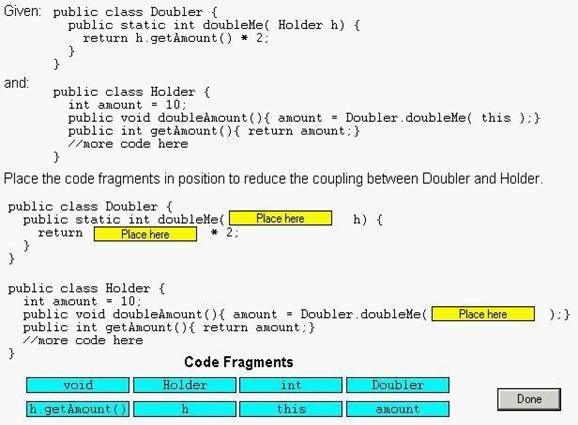Page: 12
8. OOPs
Q: 51 Which Man class properly represents the relationship "Man has a best
friend who is a Dog"?
A. class Man extends Dog { }
B. class Man implements Dog { }
C. class Man { private BestFriend dog; }
D. class Man { private Dog bestFriend; }
E. class Man { private Dog<bestFriend>; }
F. class Man { private BestFriend<dog>; }
Answer: D Q: 52 Given:
10. interface Foo { int bar(); }
11. public class Sprite {
12. public int fubar( Foo foo ) { return foo.bar(); }
13. public void testFoo() {
14. fubar(
15. // insert code here
16. );
17. }
18. } Which code, inserted at line 15, allows the class Sprite to compile?
A. Foo { public int bar() { return 1; }
B. new Foo { public int bar() { return 1; }
C. new Foo() { public int bar() { return 1; }
D. new class Foo { public int bar() { return 1; }
Answer: C Q: 53 Click the Task button. 
Solution: 1. int 2. h 3. amount. Q: 54 Given classes defined in two different files: 1. package packageA;
2. public class Message {
3. String getText() { return "text"; }
4. }
and:
1. package packageB;
2. public class XMLMessage extends packageA.Message {
3. String getText() { return "<msg>text</msg>";}
4. public static void main(String[] args) {
5. System.out.println(new XMLMessage().getText());
6. }
7. }
What is the result of executing XMLMessage.main?
A. text
B. An exception is thrown at runtime.
C. Compilation fails because of an error in line 2 of XMLMessage.
D. Compilation fails because of an error in line 3 of XMLMessage. Answer: D
Page: 12
1
2
3
4
5
6
7
8
9
10
11
12
13
14
15
16
17
|